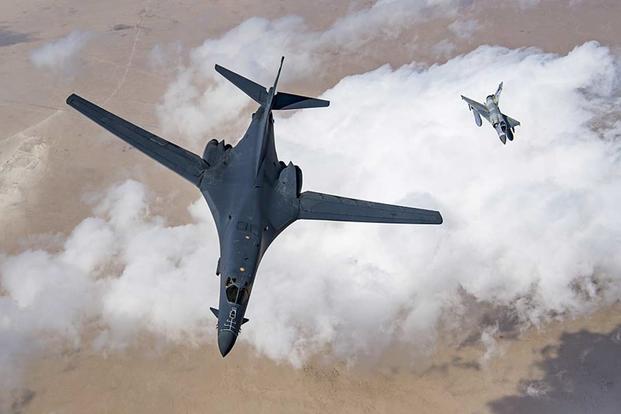On April 14, 2018, two B-1B Lancer bombers fired off payloads of Joint Air-to-Surface Standoff Missiles against weapons storage plants in western Syria, part of a shock-and-awe response to Syrian President Bashar al-Assad's use of chemical weapons against his citizens that also included strikes from Navy destroyers and submarines.
In all, the two bombers fired 19 JASSMs, successfully eliminating their targets. But the moment would ultimately be one of the last -- and certainly most publicized -- strategic strikes for the aircraft before operations began to wind down for the entire fleet.
A few months after the Syria strike, Air Force Global Strike Command commander Gen. Tim Ray called the bombers back home. Ray had crunched the data, and determined the non-nuclear B-1 was pushing its capabilities limit. Between 2006 and 2016, the B-1 was the sole bomber tasked continuously in the Middle East. The assignment was spread over three Lancer squadrons that spent one year at home, then six month deployed -- back and forth for a decade.
Related: Anatomy of a B-1 Bomber Training Mission
The constant deployments broke the B-1 fleet. It's no longer a question of if, but when the Air Force and Congress will send the aircraft to the Boneyard. But Air Force officials are still arguing the B-1 has value to offer, especially since it's all the service really has until newer bombers hit the flight line in the mid-2020s.
Some in the Air Force are pinning hopes on new technologies to keep the B-1 fleet alive even for just a little while longer. On top of that, the Air Force must soon deliver a more fine-tuned bomber strategy that includes the B-2 Spirit and B-52 Stratofortress. Lawmakers say they want the Air Force to better explain how the service plans to sustain its legacy aircraft while ushering in the brand-new B-21 Raider.
At the same time, Air Force officials have hinted that "controversial" decisions may soon be on the way. Will the service ultimately opt to end B-1 operations prior to the aircraft's scheduled retirement in 2036?
"This is a tough choice," said Mark Gunzinger, Director for Government Programs and Wargaming at the Mitchell Institute, when describing the tradeoffs the Air Force may be forced to make.

"Put yourself in ... the Secretary of the Air Force's shoes just for a moment," said Gunzinger, a former senior fellow at the Center for Strategic and Budgetary Assessment who was also a B-52 instructor pilot.
"You need to modernize your force, which is the oldest force you've ever had, and to maintain it, it takes more and more dollars each year because old stuff ... costs more," Gunzinger said. "How do you balance when you don't have enough budget?"
But premature retirements may not be the best way forward, Gunzinger warned.
"We already know we have a shortfall on bombers," Gunzinger said. "We shouldn't try to deepen that trough to get from here to there. Don't make your capacity shortfall worse until the next generation of capabilities can join the force."
The Air Force currently maintains a total of just 157 bombers.
Related: START Lanced the B-1's Nukes, But the Bomber Will Still Get New Bombs
Pushing the Fleet
The U.S. is the only allied country that still flies bombers -- some more than 60 years old -- that over the years have been used for tactical and strategic strikes. Russia and China also have aging bombers in their inventories, but are racing to develop their own next-generation stealth bombers to rival the Air Force's B-2 and proposed B-21 Long Range Strike Bomber.
The B-21, under development by Northrop Grumman, is still years away. The Air Force plans to buy roughly 100, but could end up purchasing more depending on the service's needs. Vice Chief of Staff Gen. Stephen "Seve" Wilson last month said he's counting the days until the bomber's first flight in December 2021. But, as Gunzinger pointed out, by the time there will be "significant numbers of B-21s joining the operational force, it will be in the latter part of the 2020s or early 2030s."
Until then, Ray said, he has to work with what he has.
"In this particular period, from 2019 until, I would say, the next decade, my job right now is to set the foundation to get as much long-range strike capacity as we can," Ray said in a recent interview with Military.com. "This is planning the hand of cards we've been dealt to the best of our ability."
The Air Force has already said the B-52 will be the bomber flying well into the 2050s and perhaps even beyond. But the less-nimble 'BUFF,' short for 'Big Ugly Fat Fellow,' will also need to take time out of the deployment rotation. The Stratofortress needs eight brand-new engines for the 75-aircraft fleet, though it’s unclear if all the aircraft will receive upgrades. The service estimates it will spend more than $1.3 billion on that project alone over the next five years, according to the Future Years Defense Program assessment.
The Pentagon is requesting $175 million toward the re-engining program in its fiscal 2020 request, and anticipates awarding a contract in the coming months.
Given its particularly worn condition, the B-1 has been the focus of Ray's attention. The long-range, supersonic aircraft has flown 46,889 flight hours for overseas operations alone between 2013 and 2016, according to data provided to Military.com. Those hours do not include continuous bomber presence missions, or shorter rotations to Europe or the Pacific.
The "Bone" left the Middle East in early 2016, the first time it would be called back from forward operations for a major upgrade to its avionics suite. Air Force officials at the time said the B-1B's return to the U.S. was crucial in order to upgrade the fleet with the latest Integrated Battle Station, or IBS.
B-52 bombers arrived at Al Udeid Air Base, Qatar, that April to take over the air campaign against the Islamic State. While officials said the B-52 in that nearly two-year timeframe set records -- flying nearly 6,000 combat hours and dropping more than 2,300 munitions -- it still flew less than half of the flight hours logged by the B-1 against enemy targets, with 20,360 total hours.
Though it completed a few continuous presence rotations, the B-2, with its small fleet of just 20 bombers, largely remained stateside.
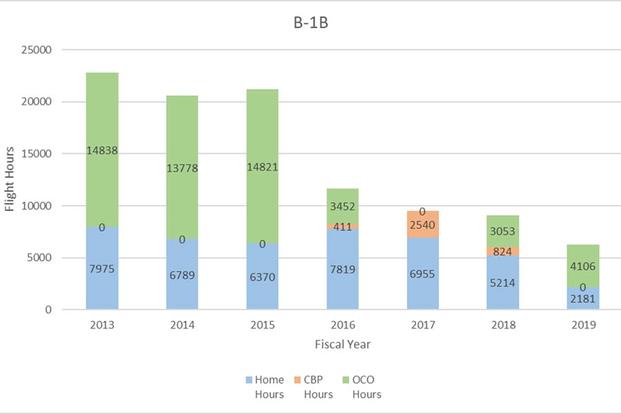
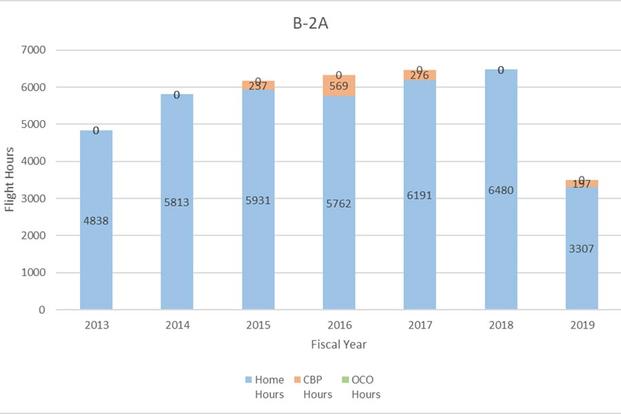
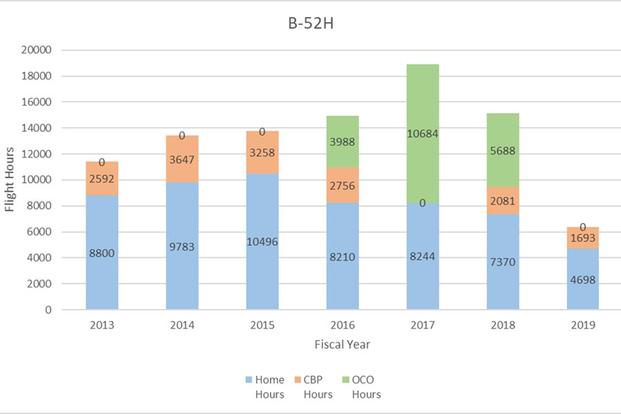
"If you run [something] past the pace that should be managed, then there's a lot of reset," Ray said.
The B-1s went back to the Middle East in 2018. But Ray soon realized the airframe had had enough, and his decision was backed by Air Force Chief of Staff Gen. David Goldfein and then-Secretary Heather Wilson, he said.
"There's sensational requirement for air power all around the globe. [But] we looked at the [National Defense Strategy] and where that's going, and the resources that we need for that particular set of conflicts is not the ones we have on the ramp right now," he said.
Then more problems came to light.
By the end of March, Ray had ordered a stand-down, marking the second fleetwide pause in about a year over a rigged "drogue chute" incorrectly installed in the ejection seat egress system. The 62 bombers in the fleet underwent a careful inspection process, and one by one, B-1s returned to flightlines starting April 23.
The command first grounded the fleet last year over a problem also related to the Lancer's ejection seats. Officials ordered a stand-down June 7, 2018, which lasted three weeks while the fleet was inspected.
The setbacks took their toll: Last month, the head of U.S. Strategic Command, Air Force Gen. John Hyten, told Senate Armed Services Committee members that only about seven bombers were ready to deploy.
A recent report from Air Force Times found the B-1's mission-capable rate -- the ability to fly at any given time to conduct operations -- was 51.75%, according to fiscal 2018 estimates. By comparison, its bomber cousins, the B-2 and B-52, have mission-capable rates of 60.7% and 69.3%, respectively.
The ongoing inspections and time compliance technical orders, or TCTOs, Ray said, "[were] a much-needed step back even though we lost a lot of flying." TCTOs often mandate modifications, comprehensive equipment inspections or installation of new equipment.
The general said he was hopeful mission-capable rates may soon improve.
"It isn't nearly as bad as we thought," Ray said of the B-1. "There's a good chance that we're done with that rash of those [inspections] ... at least by the end of this calendar year."
Keeping the B-1 Alive
The B-1 has more life in it than many think, said Senior Master Sgt. Richard Burley, B-1 Weapons System Team superintendent and director of Logistics and Engineering at AFGSC.
"We're flying now," Burley said "We're training, and if called upon, we can take action today."
"When you look at where we are, maintenance-wise, we are constantly scheduling maintenance to make sure we're in the best condition that we can possibly be so that we can perform whatever mission [is ordered]," Burley said. "So if an airplane is broken right now, that doesn't mean it's going to be broken in two hours."
That said, it will take some time to see those small successes translate into steady mission-capable rate improvements, he said.
"I don't want to say that we've had a 'return of X' based on [specific maintenance efforts] because again, it's a snapshot in time. So we may have taken an aircraft down for something completely different and the number may not change, or it may change drastically; overall fleet health is going to take time to be able to put that into a number," he said.
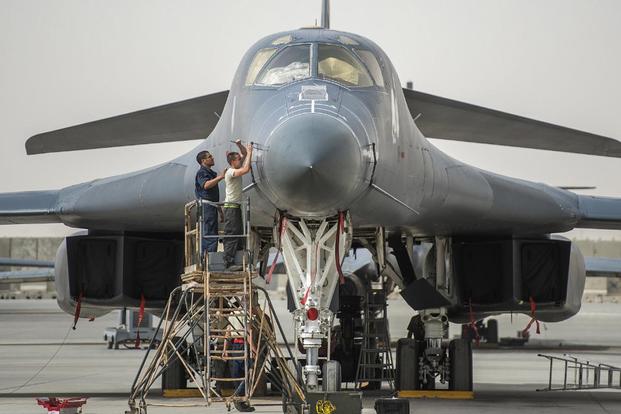
Modernization is costly. According to Air Force reports, Congress allocated $1.26 billion for modernization efforts for the B-1, and $1.23 billion for the B-2 in fiscal 2019; the Future Years Defense Program shows the bombers will need an additional $5.9 billion and $6.6 billion, respectively, over the next five years. The nearly immortal B-52, which has been in service since the 1950s, will need $9.2 billion in modernization over the next five years, according to the data.
Air Force Global Strike Command, in partnership with Air Force Materiel Command in Ohio, is now looking to streamline maintenance with a new program -- one officials believe will be a game-changer. Maintainers have begun taking every opportunity to install a predictive maintenance system, known as the condition-based maintenance technique, or CBM+, to help them see when a part may fail and to schedule a fix before it does, Burley said.
The predictive analysis can collect data on a sensor that's going to fail, or offer information about how a part may be affected by flying conditions or the weather, explained Debbie Naguy, the Air Force Life Cycle Management Center's Product Support Engineering Division chief.
The B-1 and the C-5 Galaxy transport were the first aircraft chosen to run the new program because "they have a very robust diagnostic system onboard those aircraft," Naguy said.
The technology has been used by commercial aviation companies such as Delta for years, she said.
CBM+ and another program, Enhanced Reliability Centered Maintenance, or ERCM, -- which reviews past data and maintenance records to find out at what point parts typically fail -- are expected to produce positive results by next year.
"We think in 2020, we are really going to see the big results from both of those pathways" on the B-1, she said.
CBM+ is something the B-2 and B-52 crews want, too.
Senior Master Sgt. Shaun Hardy, the B-2 Weapons System Team Superintendent, explained the community uses ERCM for the time being, but CBM+ is not currently an option.
"But we are looking at implementing it," he said. The B-2 is expected to retire in 2032.
"We're the oldest platform out there," said Alan Williams, the B-52 deputy program element monitor at AFGSC. "We are the last major in platform designed strictly with a slide rule, and … [engineers] did not have all the knowledge of stress analysis, fatigue, cracking, all of those things which are now computer-generated to a very finite detail and very well done."
"If we see benefit to it, we would be more than happy to welcome that, and integrate it into our program. We do not stay static on how we maintain these airplanes, because the airplanes are not static," he said.
Regarding the re-engining effort, Williams said crews are anticipating the change, but it’s still years away, he said. "That's in the very, very preliminary design."
Flexing for the Future
Gunzinger said the Air Force finds itself at a turning point given that no bomber at this point is in its prime.
"Our bomber force today is not, frankly, well-suited for an era of great power competition," he said.
But efforts to address that concern are met with "'God forbid, don't cut [the force],'" Gunzinger said.
Lawmakers are also concerned for the future: in the Senate Armed Services Committee markup of the fiscal 2020 budget request, members are calling on the Air Force to provide an update to its 2018 Bomber Vector Roadmap strategy that "delineates the strategy and the pathway for legacy bombers as well as the acquisition of the B-21 and its integration in the bomber force."
Lawmakers want a briefing by Feb. 1, 2020, the markup language says.
Ray said there's still time for the bombers to prove their mettle as they continue to train for the next conflict.
Global Strike is planning more short strategic bomber rotations in order to test the Air Force's agility when deploying its heavy aircraft forces around the world.
"[With] these dynamic employments... airmen come back more ready, more relevant for the future fight," Ray said. "I see these as an exceptionally wise approach."
He added he doesn't believe the missions will keep aircraft fleets, like the B-1, from undergoing maintenance.
"[The deployments are] short, they're crisp, they're not long and enduring. [And] there's something that's really important for everybody to understand -- there are no ally bombers. This is one thing that we do better than anybody else," he said.
"There's gotta be more resilience of margin, and that we continue to push back into that," he said.
-- Oriana Pawlyk can be reached at oriana.pawlyk@military.com. Follow her on Twitter at @oriana0214.
Read more: Congress Wants the Military to Report Extremism in the Ranks. Here's Why That Will Be Tough
